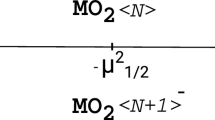Abstract
The bonded radius, r b(S), of the S atom, calculated for first- and second-row non-transition metal sulfide crystals and third-row transition metal sulfide molecules and crystals indicates that the radius of the sulfur atom is not fixed as traditionally assumed, but that it decreases systematically along the bond paths of the bonded atoms with decreasing bond length as observed in an earlier study of the bonded radius of the oxygen atom. When bonded to non-transition metal atoms, r b(S) decreases systematically with decreasing bond length from 1.68 Å when the S atom is bonded to the electropositive VINa atom to 1.25 Å when bonded to the more electronegative IVP atom. In the case of transition metal atoms, rb(S) likewise decreases with decreasing bond length from 1.82 Å when bonded to Cu and to 1.12 Å when bonded to Fe. As r b(S) is not fixed at a given value but varies substantially depending on the bond length and the field strength of the bonded atoms, it is apparent that sets of crystal and atomic sulfide atomic radii based on an assumed fixed radius for the sulfur atom are satisfactory in that they reproduce bond lengths, on the one hand, whereas on the other, they are unsatisfactory in that they fail to define the actual sizes of the bonded atoms determined in terms of the minima in the electron density between the atoms. As such, we urge that the crystal chemistry and the properties of sulfides be studied in terms of the bond lengths determined by adding the radii of either the atomic and crystal radii of the atoms but not in terms of existing sets of crystal and atomic radii. After all, the bond lengths were used to determine the radii that were experimentally determined, whereas the individual radii were determined on the basis of an assumed radius for the sulfur atom.






Similar content being viewed by others
Notes
Chalcopyrite, CuFeS2, troilite, FeS; pyrite, FeS2, marcasite, FeS2, smithite, FeS, greigite, Fe3S4, cubanite, CuFe2S3; anilite, Cu7S4; vaesite, CuS2, chalcocite, Cu2S, villamanite, CuS2, vaesite, NiS2, millerite, NiS and heazelwoodite, Ni2S3.
References
Bartelmehs KL, Gibbs GV, Boisen MB (1989) Bond-length and bonded-radii variations in sulfide molecules and crystals containing main-group elements; a comparison with oxides. Am Mineral 74(5–6):620–626
Batsanov SS (2013) Cationic radii from structures of extremely compressed solids. Acta Crystallogr Sect B-Struct Sci Cryst Eng Mat 69:563–569
Bragg WL (1920) The arrangement of atoms in crystals. London, Edinburgh, and Dublin Phil. Mag. J Sci 40:169–189
Downs JW, Ross FK, Gibbs GV (1985) The effects of extinction on the refined structural parameters of crystalline BeO—a neutron and gamma-ray diffraction study. Acta Crystallogr B 41(DEC):425–431
Gibbs GV, Finger LW, Boisen MB (1987) Molecular mimicry of the bond length-bond strength variations in oxide crystals. Phys Chem Minerals 14(4):327–331
Gibbs GV, Downs RT, Prewitt CT, Rosso KM, Ross NL, Cox DF (2005) Electron density distributions calculated for the nickel sulfides millerite, vaesite, and heazlewoodite and nickel metal: a case for the importance of Ni-Ni bond paths for electron transport. J Phys Chem B 109(46):21788–21795
Gibbs GV, Cox DF, Rosso KM, Ross NL, Downs RT, Spackman MA (2007) Theoretical electron density distributions for Fe- and Cu-sulfide earth materials: a connection between bond length, bond critical point properties, local energy densities, and bonded interactions. J Phys Chem B 111(8):1923–1931
Gibbs GV, Ross NL, Cox DF, Rosso KM, Iversen BB, Spackman MA (2013) Bonded radii and the contraction of the electron density of the oxygen atom by bonded interactions. J Phys Chem A 117(7):1632–1640
Gibbs GV, Ross NL, Cox DF, Rosso KM (2014) Insights into the crystal chemistry of earth materials rendered by electron density distributions: Pauling’s rules revisited. Am Mineral 99(5–6):1071–1084
Gibbs GV, Ross NL, Cox DF (2015) Bond length estimates for oxide crystals with a molecular power law expression. Phys Chem Miner 42(7):587–593
Johnson O (1973) Ionic radii for spherical potential ions. I. Inorg Chem 12:780–785
Megaw HD (1973) Crystal structures: a working approach. W.B. Sauders Co., Fairfax, VA, p 563
O’Keeffe M (1981) Some aspects of the ionic model of crystals. In: O’Keeffe M, Navrotsky A (eds) Structure and bonding in crystals, 1. Academic Press, New York, pp 299–322
Pauling L (1927) The sizes of ions and the structure of ionic crystals. J Am Chem Soc 49(3):765–790
Pauling L (1948) The modern theory of valency. J Chem Soc 0(0):1461–1467
Pyykkö P (2012) Refitted tetrahedral covalent radii for solids. Phys. Rev. B 85(2)
Shannon RD (1976) Revised effective ionic radii and systematic studies of interatomic distances in halides and chalcogenides. Acta Crystallogr A 32(5):751–767
Shannon RD (1981) Bond distances in sulfides and a preliminary table of sulfide crystal radii. In: O’Keeffe M, Navrotsky A (eds) Structure and bonding in crystals, 2. Academic Press, New York, NY, pp 53–70
Shannon RD, Prewitt CT (1969) Effective ionic radii in oxides and fluorides. Acta Cryst B25:925–946
Slater JC (1964) Atomic radii in crystals. J Chem Phys 41(10):3199–3204
Acknowledgements
GVG thanks Virginia Tech for providing generous travel funds since his retirement in 2000, NLR acknowledges NSF EAR-1118691, and DFC acknowledges financial support by the Chemical Sciences, Geosciences and Biosciences Division, Office of Basic Energy Sciences, Office of Science, US Department of Energy through Grant DE-FG02-97ER14751.
Author information
Authors and Affiliations
Corresponding author
Rights and permissions
About this article
Cite this article
Gibbs, G.V., Ross, N.L. & Cox, D.F. Sulfide bonded atomic radii. Phys Chem Minerals 44, 561–566 (2017). https://doi.org/10.1007/s00269-017-0883-4
Received:
Accepted:
Published:
Issue Date:
DOI: https://doi.org/10.1007/s00269-017-0883-4




